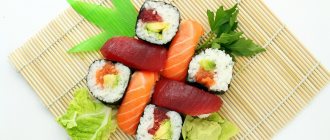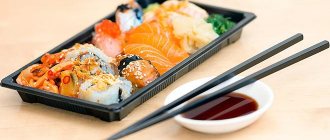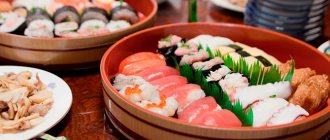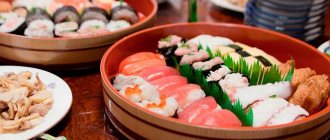History of the origin of sushi
It is generally accepted that sushi and rolls are purely Japanese dishes. However, this is absolutely not true. Who invented sushi? The original homeland of this dish is in South Asia. The future traditional Japanese dish originated in Ancient China. Initially, the Chinese caught fish in the sea, and then cleaned it and cut it into thin plates, which they stacked on top of each other. Huge and heavy stones were placed on top of the fish to create pressure. In this form, the sushi should have lain for about two to three weeks. Then, instead of stones, thin copper sheets were used. This whole process was necessary for the fish to ferment. And after a couple of months the dish was considered ready.
Sushi came to Japan only at the end of the 19th century. The Chinese immediately fell in love with the Japanese. Japanese chef Yuhei is the one who invented sushi. He suggested presenting sea fish raw. After some time, traders came up with a new combination of different fish with rice and curd cheese. The dish began to gain popularity. In the mid-20th century, it became a favorite delicacy in many countries around the world. In history, it is still generally accepted that the Chinese are the ones who invented sushi.
History of sushi
The history of the invention of this popular dish goes back more than 1300 years. The name sushi (or “sushi” - there is still debate about the correct pronunciation of the hieroglyph 寿司), oddly enough, is not translated in any way. Or, more precisely, there are so many interpretations of the two hieroglyphs that make up this word that it can be interpreted with equal success as “pickled fish”, and as “preparation for longevity”, and as a wish for happiness. As often happens with ancient cuisines, which include Japanese, the invention of a dish has nothing to do with its culinary merits, but with the method of storing a particular product.
It is believed that the Japanese first combined raw fish and rice in order to store fish, and this happened in the 6th century AD. According to other sources, the invention was made a thousand years earlier, and its honor belongs to the inhabitants of Southeast Asia, from where it reached China. And the secret of storing fish in rice came to Japan from the Chinese. Gutted carcasses of silver crucian “funa” were tightly covered with rice, placed in barrels, topped with salt, and natural fermentation took place for several weeks. Then they ate the fish and threw away the rice, which, of course, was extremely wasteful, but still better than getting poisoned in the era before the invention of the refrigerator.
At the end of the 17th century, with the growth of rice production, rice vinegar began to be prepared from it, which in turn began to be added to rice to give a piquant sour taste, and fish and seafood with such rice began to be served raw, that is, fermentation was excluded from the cooking process . At first there were special wooden forms for pressing rice, but sushi in its modern form appeared not so long ago - in the 19th century, and this happened in the city of Edo, as Tokyo was then called.
A simple sushi master named Johei (only representatives of the samurai class had the right to use their surname, other subjects in the so-called Edo period were content with the name) first made a bun out of rice, added a little wasabi (Japanese horseradish, which has been known for a long time as best antiseptic) and covered it all with a piece of fish. The dish was called nigiri sushi. Nigiri means “handful” in Japanese; that’s how much rice you take to eat at one time. The Japanese usually eat with chopsticks, but they also like to eat nigiri sushi with their hands.
After the Second World War, when Japan was going through difficult times, portion sizes were strictly rationed, and a sushi master, regardless of where he worked, in Tokyo, Osaka or Kyoto, had to prepare ten nigiri from one glass of raw rice. sushi and one sushi roll.
True sushi lovers know that they should order different types of sushi at different times of the year. And this is true not only because, depending on the season, tuna, licorice or mackerel can cost completely differently. For example, herring is a winter fish in Japan; it is quite cheap in February, but in August you will pay for it like a delicious eel. And yet, the main thing is not the price, but the quality of the fish: you need to know in what month and even week this or that component of your favorite food achieves its best taste.
They say that sushi in Japan is cheaper than, say, in Moscow. In fact, this dish has never been cheap, and the only way to save significantly is to cook it at home, which is what many Japanese housewives do, although the hostess will definitely apologize to the guests, because cooking sushi is a complex science and the intrusion of the uninitiated into it is something kind of like sacrilege. Courses for sushi chefs last up to three years, and it is impossible to learn all the intricacies of their craft on your own at home.
Sticks
Chopsticks are used by two billion people on the planet: residents of China, Japan, and Southeast Asia. Chinese and Japanese cuisine is becoming popular nowadays among residents of America and Europe, so the ability to use chopsticks is useful for everyone. Chopsticks are difficult to master, but for those who have learned to master them perfectly, they are a convenient and versatile cutlery. The specificity of eating with chopsticks determined the method of preparing Japanese dishes, served mainly in the form of small individual pieces (sushi rolls, sashimi), which you just need to pick up and put in your mouth.
Hashi chopsticks came to Japan from China. In the 12th century, the chopsticks were made of bamboo, and only emperors ate with them. These were real masterpieces: they were painted, encrusted with precious stones, hand-painted and varnished. Modern sticks are made of wood (bamboo, cypress, sandalwood or plum) or ivory. Japanese chefs use metal chopsticks for cooking. Nowadays, disposable waribashi sticks are widely used, which are made of wood that has been sawn lengthwise slightly incompletely, so that they must be broken before use.
Rice
Rice is so important to the Japanese that the word "gohan" means not only cooked rice, but also simply food. Any meal is considered incomplete if rice is not served at the end. It is known that the culture of rice cultivation has a history of more than four thousand years. It came to the Japanese archipelago from China through Korea, which has been reliably established by archaeologists, but the appearance of this universally revered culture is surrounded by myths and legends.
The Japanese also have a special Deity of rice - Inari-sama. According to one legend, it was she who brought this plant to the country from distant travels, hiding several grains in a cane staff so that no one would know that it had stolen them. In ancient times, people believed that rice, like a person, has a soul and if you treat it with disrespect, you can pay for it. “Ancient Fudoki” (Records of Antiquity. Geographical Description of Ancient Provinces) tells how the peasants of one of the villages, having reaped a good harvest, became rich, became lazy, began to drink sake and have fun. Once, during an archery competition, they made a target out of a rice cake... The offended soul of the rice could not stand such sacrilege, turned into a white bird and flew away. After this, the rice fields there became desolate, and people died. So they were punished for neglecting their main food product.
The abundance of legends about rice is explained by the fact that in ancient times human existence depended on it. It was not only an everyday and ritual food, but also a “currency” for paying taxes and paying salaries. Rice was a measure of wealth. In ancient times, tribal leaders stored it in special barns called “okura”. And it is no coincidence that in modern Japan one of the powerful ministries - finance - is called "okurasho". Having a lot of rice has always been the dream of the people of the Japanese islands.
Seafood
When preparing sushi from the very first days, such types of seafood as tuna, yellowtail, snapper, eel, mackerel and salmon were used. As well as squid, octopus, shrimp, fish roe, sea urchin (uni) and various types of shellfish. However, oysters are not used in sushi because their taste does not combine with the taste of rice. All seafood is low in calories: they contain fewer calories than even the leanest chicken and any other meat. They provide the body with high-quality proteins and minerals - such as iodine, zinc, potassium, phosphorus. Fish and seafood are also rich in vitamins, in particular group B. The omega-3 fatty acids contained in fish oil are very beneficial for the cardiovascular system. They prevent the formation of blood clots, narrowing of the arteries and reduce the risk of heart attacks.
Seasonings
Ginger (gari)
Ginger is the aromatic root of a tropical plant native to Northern India. Ginger is perhaps the healthiest of spices. In Sanskrit it is called “vishvabhesaj”, which means “universal medicine”. Pungent in taste, it belongs to the category of “hot spices” that kindle the fire of digestion and improve blood circulation. Dry ginger flakes and ground ginger are slightly spicier than fresh ginger and more penetrating.
The history of ginger is rooted in ancient times. The English scientist Frederick Rosengarten talks about the mention of ginger in the works of the Chinese philosopher Confisius, who lived back in 500 BC. In India and China, ginger has been used as a spice and medicine since time immemorial. Mentions of ginger are found in the sacred texts of the Koran; The ability of ginger to arouse passion and sexual desire is discussed in the Arabian Nights.
In his book “The Book of Spices,” Rosengarten writes that in the fifth century AD, ginger plants were grown in pots that sailors took with them on long sea voyages to protect themselves from scurvy and adding ginger to food would keep it fresh for a long time.
According to reliable historical information, ginger was very popular among the ancient Greeks and the inhabitants of the Roman Empire, who purchased this spice from Arab merchants who kept the origin of ginger secret. In the first century AD, ginger was the subject of study by scientists such as Dioscorides and Pliny; the latter often refers to it in his work De Materia Medica, describing its warming effect, its benefits for digestion and even mentioning it as an antidote.
Wasabi
It is the dried and crushed root of the plant of the same name. The consumption of wasabi in the form of grated root began in 1396 in the Shizuoka region. Residents of Shizuoka brought wasabi as a gift to the future shogun. According to legend, he liked the seasoning and began to distribute wasabi in other regions of Japan.
Wasabi grows along the banks of mountain rivers. The cultivation of this plant began in the 10th century. There are two agricultural techniques: growing in cold mountain water in a semi-submerged state (hon-wasabi) and in the garden. The second variety is considered to be of lower quality; wasabi grown on the banks has a brighter taste. Wasabi is cultivated in Taiwan, the USA, China, Korea and New Zealand.
Thanks to special substances - isothiocyanates - Japanese horseradish prevents tooth decay. Studies have shown that these substances inhibit the growth of bacteria that cause tooth decay. Thanks to the same isothiocyanates, wasabi is supposed to be used to fight cancer. In addition, wasabi is known to prevent the formation of blood clots and play the role of an anti-asthma component. And the extreme popularity of the seasoning in combination with raw fish can be explained by its strong antimicrobial properties.
Due to the high cost of wasabi, the vast majority of restaurants, both in Japan and abroad, use imitation wasabi based on horseradish, spices and food coloring. Imitation wasabi is produced in the form of powder or ready-to-use paste in tubes.
Today, Japanese cuisine has become widespread and is extremely popular all over the world. This popularity is largely explained by the truly philosophical attitude of the Japanese towards food in general - products must be healthy. Therefore, we can say with absolute certainty that the longevity of the Japanese nation is directly related to what they eat.
Information about sushi.
The difference between sushi and rolls
We have no idea how these two dishes differ. Traditional rolls and sushi in Japan are prepared by chefs from round rice and fish or seafood. Their main difference lies in the method of preparation. Place a piece of red salmon, tuna or shrimp on top of the boiled rice. Sushi is not wrapped in fish or seaweed, but rolls are the opposite. This is where their name comes from the English word roll, which translates as “to wrap”. Rice is placed on seaweed, then fish, avocado and cream cheese. All this is rolled up and cut.
What is sushi
Sushi or sushi (すし) are several types of dishes made from rice with vinegar, seaweed and seafood. California rolls, beloved by the population of the CIS, have only a conceptual relation to sushi. Thin maki rolls or gunkans served in specialized establishments are much closer to traditional recipes.
Modern sushi is divided into traditional and non-traditional. The first include dishes prepared using classic recipes and cooking technologies. The second includes all types that were invented outside Japan or adapted to the preferences of local consumers.
Who invented rolls?
What you find out next may surprise you. The ancestral home of rolls is the United States of America, and not Japan, as many believe. In the early 70s of the twentieth century, the first Japanese restaurants began to open in the United States. However, not many Americans enjoy traditional Japanese sushi. Then the chefs decided to come up with a new way to prepare them. They began to roll rice and fish into compressed seaweed called nori. For example, the world-famous California roll was invented by American chef Ichiro Masita in Los Angeles in 1973. Then Ichiro did not suspect that many years later “California” would become one of his favorite types of rolls. What types of sushi are there? Let's find out together.
From Japan to America. How sushi and rolls became a fashionable international dish.
The traditions of Japanese cuisine first crossed the ocean and became known in Europe and America at the beginning of the 20th century. During the Meiji era, many Japanese emigrated to the United States and Europe. It was thanks to emigrants that sushi acquired its current universal international shape.
After the first penetration of land "to the west", their fame did not last long. The fact that sushi did not immediately gain recognition outside of Japan is often attributed to political reasons. In the first half of the 20th century, Japan had a dubious reputation on the world stage, the Japanese opposed the United States in World War II, and it was quite natural that Americans did not want to eat Japanese food.
The “hits” of Japanese cuisine gained real popularity in the 70s and 80s of the 20th century, and then its modern variations arose. It was unusual for Europeans and Americans to eat raw fish, and they replaced it with lightly salted fish, adding some new ingredients to the rolls.
The black nori wrapper also seemed strange to some residents of Western countries, so it was in America that the so-called “uromaki” - rolls with the rice facing out - arose. In 1973, “turn the roll” was invented by an emigrant chef working in Los Angeles, Ichiro Mashito. The chef decided to “experiment” and added the “exotic” avocado fruit inside the roll, paying attention to its suitable structure. This is how one of the most popular rolls appeared, named “ California” after the place of its invention.
Other currently popular rolls have appeared in a similar way - the idea, tradition and methodology in them are Japanese, but the filling and implementation are North American.
The popularization of Japanese cuisine in general, and roll sushi in particular, is often associated with the name of Nobu Matsuhisa. He was born and raised in Japan and, already as a cook, moved to live in Latin America, in the capital of Peru, the city of Lima. In a sunny Spanish-speaking country, the Japanese began to promote the traditions of their native cooking and “adapted” local products for Japanese dishes. After Peru he lived in Chile and the USA. In America, Matsuhisa met and became friends with Robert de Niro. The Hollywood artist liked the cuisine from the eastern country, and he contributed to an increase in interest in sushi and its many varieties among American celebrities. Matsuhisa even appeared on the silver screen in one of Michael Scorsese's films.
Actor Robert De Niro (left) and chef Nobu Matsuhisa (right)
Together, De Niro and Matsuhisa opened several establishments; in the late 80s and early 90s they gained popularity in the states. The Japanese chef has become an iconic figure in the history of not only national, but also world culinary. He is considered one of the main super-chefs of our time, and the name Matsuhisa has become a brand inextricably associated with Sushi.
Because of the Soviet “Iron Curtain,” sushi and rolls came to Russia late in a version “adapted” for Westerners. Although the first Japanese restaurant in Moscow, Sakura, opened quite early - in 1980. You understand what kind of era it was. For the Soviet people, whose daily life was constant in scarcity, the mysterious Japanese delicacies became unaffordable exoticism.
Most Soviet and then Russian citizens had never heard of what sushi was at least until the mid-1990s. But the real boom began only in the current millennium.
Many Russians still treat “raw fish” with distrust, and will not go to any Japanese restaurant. However, ordering sushi for lunch at the office or on a holiday has become a good tradition.
The main filling for the rolls is seafood, which is not typical for the traditional diet of Russian people. They are usually not cheap. The high cost of this dish in deliveries and cafes encourages housewives to experiment and try to roll the rolls themselves.
Russian people are also rich in imagination and can think of wrapping anything in a roll, for example, lake pike, and instead of masago caviar, you can use dill grown in the garden as a topping.
So, Russian families have probably already “invented” new types of rolls, which neither the Japanese nor the Americans even know about. And the dish, which arose from “rice rotting in fish,” has become truly popular.
Tell friends:
Anatoly Yagodkin
Historian, journalist, popularizer of science, music and literary critic. Creator, administrator and main author of the HUMANITAR-MEDIA portal
Classification
There are many types of sushi and rolls in the world. We will tell you about the most famous:
- Makizushi are rolls that are cylindrical in shape. Japanese chefs prepare them from rice and various fillings, rolling them into a sheet of nori.
- Uramaki are square sushi rolls. Their peculiarity is that the nori is on the inside and the rice is on the outside. They are also most often wrapped in red fish.
- Hosomaki are small rolls made of rice, cream cheese and avocado, wrapped in a sheet of seaweed.
- Oshizushi. Such sushi is pressed using a special block of wood, which is usually called “oshibako”. They consist of several layers: rice, fish, cream cheese and rice again. You can also put a piece of salmon or seafood on top.
- Temaki are huge rolls that the Japanese make by hand. Usually they do not spare fillings, so the more rice, cheese, fish, the better.
- Inarizushi is a hot bag made from Tofu cheese and filled with seafood rice. Quite an unusual type of sushi, isn't it?
- Chiradshizushi is a classic type of sushi. Place raw fish and avocado on top of boiled rice.
- Futomaki are rolls that can contain several types of filling.
How did sushi come about?
The history of the appearance of this dish dates back to the 4th century BC, but in another Asian country - China (other sources claim that it was Thailand). Ancient sailors were concerned about preserving their fish catch for many months or years, so they came up with the idea of layering raw fish with rice. Lactic acid, which is found in rice grains, helps speed up the fermentation process, and in this case, the caught catch was ready for consumption in a few days and was stored for more than two years.
At first, the rice used for storing and salting fish was thrown away because it was decomposing, but the addition of special rice vinegar allowed the first semblance of this dish to be born - nari-sushi. This variety consists of a small piece of salted fish and a lump of rice. They are still sold in some specialty restaurants in Japan.
This dish came to Japanese chefs only in the 8th century AD, and they changed the recipe and began to use fresh, only caught fish, treated with marinade, and not fermented. Then sei-sei sushi appeared, which around the 17th century turned into haya sushi - they began to add vegetables and other fillings.
Preparation
Let's make delicious rolls with crab meat together. We provide a step-by-step recipe for you:
- First of all, you need to rinse the rice well under cold water.
- Next, place foil on the bottom of the pan and pour round rice into it.
- Then you need to pour in enough water to completely cover the rice. Then you should put it to cook. When it boils, you need to let it sit for 10 minutes and then drain the water.
- Afterwards you need to prepare the dressing for the rolls. You need to add fine-grained salt and granulated sugar to the rice vinegar and mix well until the grains are completely dissolved.
- Then you need to pour the vinegar into the boiled rice and stir.
- Next, you need to take a bamboo mat and cover it with cling film. Then place a sheet of pressed seaweed on it.
- Spread the finished rice evenly over the surface of the nori, leaving 1.5 cm from the free edge.
- On top of the rice you need to put red caviar, which is called “tobiko”. The sheet must be turned over so that the cooked rice is on the outside.
- The surface of the nori should be covered with a thick layer of cream cheese.
- The avocado must be washed, peeled and pitted, and then cut into slices. It should be placed on top of the cream cheese.
- Next, you need to cut the crab meat and put the avocado on top.
- You can begin to form “California”. You need to roll the roll into a roll by pressing on it. Then cut and serve with ginger, wasabi and soy sauce.
California is ready! Bon appetit!
Method of preparation and ingredients
Sushi
You don't need any special kitchen utensils to make sushi. All you need is your hands. With wet hands, an oblong rectangle of rice is formed, moistened with rice sauce, and a piece of some seafood is placed on top:
- Shrimp.
- Eel or salmon.
- Yellowtail.
- Smoked tuna.
- Grebeshkov.
- In rare cases, a thin slice of avocado and a “string” of nori.
Sushi is prepared only with seafood: shrimp, scallops, salmon, tuna
Rolls
For rolls, you will already need additional “tools” - a mat for making bamboo rolls (mat). A sheet of nori is laid out on it, then the filling and, thanks to its plasticity, it easily helps us roll a beautiful, appetizing roll. Then it is cut into small pieces (from 6 to 12). This is one serving. There are two ways to roll the rolls: with the filling inside - nori on top (norimaki), with the filling out - nori inside (uramaki). The latter are usually decorated with tuna shavings or flying fish caviar; you can also often find rolls sprinkled with sesame seeds. Unlike sushi, which can only contain seafood, the filling of rolls can be vegetable, meat, cheese and even fruit:
- Salmon, eel, mussels, caviar.
- Cucumbers, tomatoes, sweet bell peppers, Chinese cabbage, avocado.
- Shrimps.
- Chicken, bacon.
- Omelette.
- Feta cheese, parmesan.
- Mango, kiwi, banana, coconut, melon, peach, pineapple.
Unlike sushi, which can only contain seafood, the filling of rolls can be vegetable, meat, cheese and even fruit.
"Philadelphia"
This roll is similar in preparation to “California”. However, crab meat is replaced with salmon or trout. For this you need to stock up on the following products:
- round rice - 500 grams;
- special vinegar for sushi;
- salmon or trout (salmon can also be used) - 250 grams;
- nori sheets - 8-10 pieces;
- ripe avocado (it can also be replaced with fresh cucumber);
- fine grain salt;
- a little sugar;
- cream or cottage cheese.
International sushi
In recent years, truly delicious sushi has ceased to be a dish exclusively of Japanese cuisine. There are many variants and fillings appearing in different countries around the world. Today you can even find recipes with lard. Their shape also changes.
It is worth noting that sushi is valued not only for its attractive appearance, but also for the fact that this dish contains all the components necessary for the human body. It is low in fat and calories. At the same time, it contains many trace elements and amino acids. That’s why people who care about their figure and proper nutrition like them so much.
You just have to be careful with sushi prepared according to Western recipes. They may not have that same balance.
Recipe
Anyone can prepare a Philadelphia roll without much effort at home. For beginners, we recommend purchasing a sushi making kit. It contains a bamboo mat, nori sheets, round rice, special vinegar, soy sauce, ginger, wasabi and teaching sticks.
We provide a detailed recipe:
- First you need to cook the rice. We wrote above about how to do this.
- Next, you need to pour rice vinegar into a deep container, add sugar and fine-grained salt to it. The vinegar should be slightly warmed.
- Then you need to pour the rice vinegar into the rice and let it soak.
- Afterwards, peel the cucumber or avocado and cut it into thin slices.
- You must first prepare a bamboo mat by covering it with film.
- Next, take a sheet of nori, place the finished rice on it, and then turn it over.
- Now you need to carefully grease a sheet of pressed seaweed with curd cheese, and then lay out the avocado or cucumber.
- The last step is to roll the roll well and cut it. You can put pieces of salmon or salmon on top. It will be very tasty.
Background of sushi. Fish storage method
The origins of the dish known as sushi date back to the early Middle Ages. His backstory begins not in Japan, but in China. According to the most popular version of the origin of sushi, it was in the Celestial Empire that a method of storing fish was invented, which gave rise to the future popular delicacy of “oriental origin.”
The Chinese came up with the idea of preserving and preserving the meat of freshly caught sea creatures by layering their carcasses with layers of rice. The two main components of the future popular dish reacted, the rice was fermented, its juices were absorbed into the fish, preventing it from spoiling.
Around the 7th century AD, the method of storing “fish in rice” gained popularity and became widely used in East Asian countries, including Japan.
Sometimes they write that the Japanese were among the first to use “canned rice”; some believe that the method first came from China to Thailand, and from there to the land of the rising sun. For us, it is not so important who exactly came up with the idea of storing fish in rice. It was the Japanese who went further than everyone else, eventually turning the method of preserving the product into a culinary recipe. There are several versions of the meaning of the word “sushi”; there is no exact interpretation of the hieroglyph meaning the dish. According to the most popular, “sushi” (or “sushi”) means “marinated fish.” This is not logical. After all, in the classic Japanese sushi recipe known today, the fish is raw. The answer is simple - the name refers to the origins of the dish, to the method of marinating.
Tips from chefs
Learning how to skillfully prepare delicious rolls is quite difficult, but quite possible. Some will need a couple of weeks to do this, while others will study for years. Experts shared several recommendations that will allow you to prepare perfect sushi:
- The most difficult thing about making rolls is cooking the round rice correctly. Sometimes 15 minutes is not enough for this. It should not be damp or, conversely, sticky. Experts advise covering the pan with a lid to prevent steam from escaping from under it. Then you will have the correct consistency of rice. Some chefs recommend covering the rice with a cotton towel while cooking.
- Before cooking, put the fish in the refrigerator for 20 minutes to keep it cold.
- The knife must be sharp. To prevent anything from sticking to it, you can periodically moisten it in rice vinegar.
- For rolls and sushi, it is best to choose red fish. For example, salmon, salmon, trout or tuna. It is not recommended to purchase frozen fish. It's better to buy fresh.
- Before cooking rice, add a little salt to the water.
- The fish must be cleaned of small bones.
- Under no circumstances should you replace cream cheese with processed cheese, as the taste of the rolls will be very different from the real thing. It is best to buy Philadelphia or Almette. You can also choose “Feta” as the most budget option.
Prototype of a popular dish
The tradition of making sushi originated in South Asia many centuries ago. Thais, Japanese, and Chinese have long eaten pickled and pickled fish. The Chinese character for "sushi", or more specifically "sushi", means "marinated fish".
The history of the creation of sushi includes 2 versions. According to the first homeland of the dish, it is southeast Asia. The recipe was first used by the Thais, and in the 7th century the Japanese and Chinese learned about it. According to another version, sushi appeared in Japan and only then migrated to China and Thailand. Both versions are quite reliable. In all Asian countries, rice is the national food and they did not experience a shortage of it, so they could easily use it as a preservative. Fish is also a common part of the diet for the Thais, Chinese and Japanese. Therefore, each of them has a claim to the right to invent sushi.
Be that as it may, the history of sushi began with the preservation of fish in rice. And it dates back more than 1300 years. Initially, cleaned fish for long-term storage were stuffed with salt, placed in wooden barrels and pressed down with a stone for salting. This is the so-called brine salting, which is still used by many fishermen to salt their catch. Only the brine is not drained, so the fish gradually begins to ferment. It stays in this state for 10 to 30 days. Then the fish was taken out, placed in water to soak for 20-60 minutes, then moved to another barrel, layered with rice. For several months (about six months), the process of fermentation of the fish-rice mixture took place; it seemed to be fermented. When liquid appeared on top of the barrel, it was removed.
When fermentation ended and the rice turned into a viscous sticky mass with a disgusting smell of rotten fish, it was thrown away. Rice, due to fermentation with lactic acid bacteria, made it possible to keep fish suitable for consumption throughout the year.
Around the 7th century, they began to preserve fish in Japan. And now they prepare a very similar dish called narezushi. It quickly acquired the status of a delicacy, consumed only by members of the imperial family and persons close to them.
Hot rolls
For those who want to try making hot rolls, we have prepared a simple recipe. Ingredients:
- round rice - 450 grams;
- fresh salmon or salmon - 200 grams;
- salt, sugar;
- vinegar;
- Red caviar;
- egg;
- olive oil;
- breadcrumbs;
- cream cheese;
- ripe avocado.
These rolls can also be baked in the oven. It will also be very tasty if you replace the red fish with crab or squid meat.
Recipe:
- You need to cook the rice, and then pour vinegar into it, add salt and sugar.
- Spread boiled rice over a sheet of nori and top with cream cheese.
- Next you should add salmon fillet or crab meat, avocado slices.
- The roll needs to be rolled.
- Then you need to soak it in the egg and sprinkle breadcrumbs on all sides.
- The roll should be fried in olive oil over low heat, then cut and decorated with red caviar.
You can add anything to sushi. It all depends on your individual tastes and preferences. The main thing is to show your imagination. And we, in turn, wish you to enjoy the process of preparing a traditional Japanese dish.
Ingredients for sushi. Cooking secrets
Now, answering the question, what is sushi, you know that the fundamental ingredient for this dish is rice. The classic recipe uses the Japanese short-grain variety, which has a high gluten content. It is seasoned with sweet vinegar, salt and sugar. In some cases sake. Its main property is stickiness.
At the same time, it is tougher than what we are more familiar with, because sushi rice is cooked in a small amount of water. To ensure the desired consistency, it is cooled by stirring in a wooden bowl. It is important to cool the rice to room temperature before preparing sushi rice.
Another ingredient is nori. These are thin plates of fried seaweed that rolls are wrapped in. As a filling I use all kinds of fish, for example salmon, herring, tuna or mackerel. Most often, the fish is raw, but sometimes salted and even fried can be used. Often fish is replaced or combined with seafood. Oysters, shrimp, clams, crabs, and octopus are used.
Among the varieties of sushi there are dishes with pickled or fresh vegetables and even fruits. The cooks add cucumber, daikon, apples, avocado, and onions. You can also add cheese or tofu.
Soy sauce is always served specially with sushi. This way the taste is enhanced. Sushi is also traditionally seasoned with wasabi. This is a hot sauce that is bright green in color. And also pickled ginger, which is called gari. It helps refresh the taste buds to fully experience the differences between one type of sushi and another.
The Japanese most often drink green tea with their dish.











